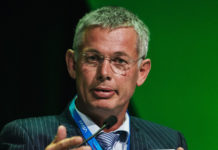
IN January, South Africa’s department of mineral resources & energy (DMRE) finally unveiled its preferred technology provider for a new minerals cadastre. The cadastre, a comprehensive real estate map that is intended to streamline the department’s beleaguered mineral licensing regime, is at least three years late.
Only the DMRE, headed by minister Gwede Mantashe, knows why it has taken so long to deliberate over so important a matter. He tends to blame others, such as the State IT Agency, which he claimed last year took too long to audit his department’s chosen technology. Surely now there can be no excuses?
The winning supplier is PMG Consortium, made up of Canada’s Pacific GeoTech Systems; MITS Institute, founded by a former senior manager of the companies registration company, CIPC; and a women-controlled geological services company, Gemini GIS. Beating better-known local technology providers, the consortium has been handed a three-year contract to build the cadastre and capture the information on the licensing system known as the South African Mineral Resources Administration (Samrad).
Talk about unscrambling the omelette. Mineral exploration companies say Samrad is an unfathomable mess. The harshest criticism is that it’s nontransparent, so it’s almost impossible to say whether an application for a certain property already exists. This leads to multiple applications for the same property, which are often granted. Cynics say that suits nefarious actors who use their part-ownership of mineral deposits to extort favourable deals from serious mining companies.
PMG Consortium’s cadastre must avoid this weakness and much more besides, such as the fact that it takes several years for a prospecting licence application to be processed. True to form, Mantashe blames the industry for failing to secure environmental authorisations in time. This was why no licence applications submitted in the year to end-March have been processed, he said in parliament last year. At last count, the licence application backlog was more than 4,000, and growing.
Mining CEOs at the Mining Indaba in Cape Town last week said it would take at least a year before the new cadastre is implemented. First, the contract awarded by the DMRE asks for a custom-built cadastre rather than off-the-shelf technology that’s supposed to be widely available. Jacob Mbele, director-general of the DMRE, said a “plug-and-play” doesn’t exist for South Africa.
That aside, there’s the question of upskilling the thinly resourced DMRE, which must also find within itself a new urgency. That looks a dim prospect. Mantashe said on the sidelines of the conference he would not rush the new cadastre into being. Even if he were inclined to push on speedily following the three-year delay, the cadastre might be difficult to implement.
Road blocks ahead
While “thrilled” to have progress, Errol Smart, CEO of junior miner Orion Minerals and chairperson of the Junior & Emerging Miners Leadership Forum, says the market should expect frustrating roadblocks.
“There will have to be rapid resolution to the dozens of title disputes so that clear, accurate, and transparent mineral title and historic geoscientific data can be available online for investors,” he says. That may require a tribunal to adjudicate, or worse, the intervention of the courts.
“Generally, system implementations like this don’t see the light of day for at least 18 months — so, years, not months,” says Paul Miller, a director of industry consultancy AmaranthCX. “A near-term benefit should not be expected as the data has to be cleaned up, much of it digitised from paper, and then migrated to the new configured system.”
The pity is that this means the exploration sector will continue to wither when it should be thriving. International investors have tended to steer clear of South Africa’s minerals industry, even though parts of the country, such as the Northern Cape, are regarded as prime real estate for new sources of energy transition minerals such as copper.
A few steely souls persevere, however. One is Jason Brewer, CEO of Marula Mining. He says half of South Africa’s 6,000 closed mines would have been reopened had they been in Australia, his home country.
Pinpointing orphaned or abandoned mines for redevelopment is another function of the cadastre. Some contain tailings that have proved a fantastically rich source of income if they can be “re-mined” using extraction technology. Lourens de Koning, COO of Fraser Alexander, specialises in this field. “You need a properly functioning cadastre for that. The sooner we get the new system in place, the better.”
A version of this article first appeared in the Financial Mail.










